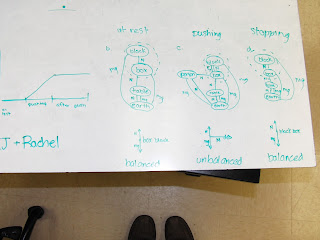We had some great whiteboard meetings as we split into five groups to construct our representations and then made sure that all of each group's representations agreed in each situation. This is good practice for looking at your own work - multiple representations not only give you multiple avenues to attack a problem, but also let you check yourself!
I encouraged them not to write these down on the sheets that I gave them with the setups, so that they can use them as independent practice later, checking back to the whiteboards for verification afterwards.
For each situation, the students evaluated each representation while the box was at rest, being pushed (and speeding up), and after it is released (after having been pushed).
The four situations were:
A rubber-bottomed cardboard box with a block inside it, on a rough floor.
A cardboard box with a block inside it, on a rough floor.
A cardboard box with a block inside it, on a smooth floor.
A cardboard box with a block inside it, on a perfectly frictionless floor.
A follow-up task for my students:
Draw v vs. t graphs for each of these four situations on the same set of axes, assuming boxes of equal weight and push forces of equal and constant size. Here's a template, along with a color-code, ready for magic markers!
Along the way, we had a great discussion about what happens to our system schema if we split the box and the block inside it (leading us to our first encounter with static friction!), and about what we can't tell about the motion from free-body diagrams (like... the direction of the motion!).
Thanks to Kelly for the great springboard to this one!









And thanks to Matt because it's a problem that I stole from him! :)
ReplyDeleteDid you do constant acceleration before you got to balanced forces? Because you aren't really only on the second unit...?!?!
And also if so, what would it take to convince you to switch the two?
:) I did indeed; I've done it both ways. They made super-easy connections between the direction that the forces were unbalanced and the acceleration, without any prompting, so that's a plus for me; since they have the tools to look at the v vs. t graph and instantly attach an acceleration direction to that, I liked the sequence this year. There are certainly good things either way.
ReplyDelete